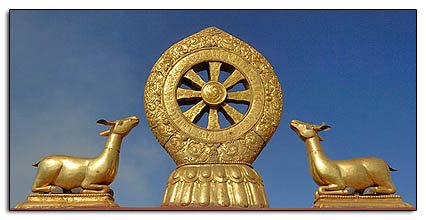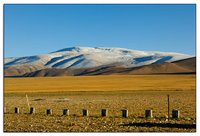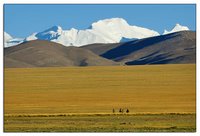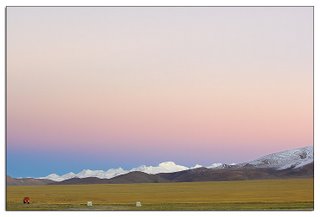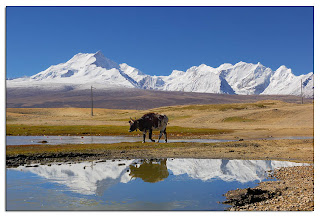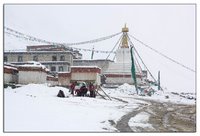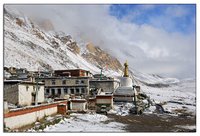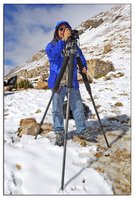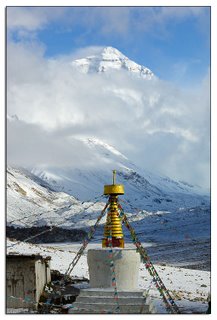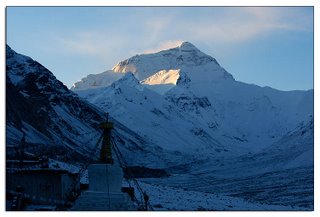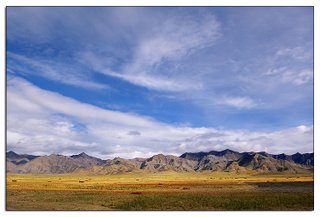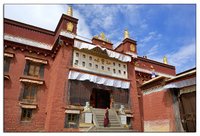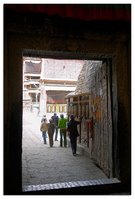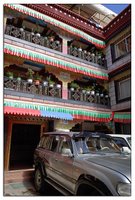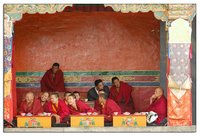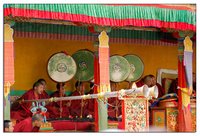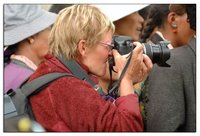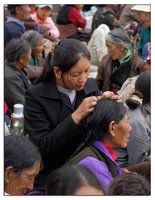Old Tingri(老定日), Mt Shishapangma (希夏邦玛峰) (9/26-9/27)

We left Rongphu monastery around 10:40am. I gave up the original plan of going to base camp of Qomolangma, because I felt I had enough good shots of the mountain, and many books I read said the view from the base camp isn't that great, when compares to Rongphu.
Mr. Danzeng got some business for him (and me as well, since we share the money), three folks,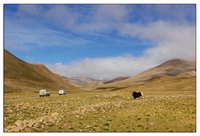 Carol, Richard & Peter, hitch-hiked our 4x4 to Old Tingri. They just came down from the Camp 1 of Qomolangma yesterday, and before that, they spent 7 days in a trail in Kangshung region (lies to the east of Mount Everest, which is considered by many the most spectacular side of the mountain). Danzeng over-charged them (Y200/person for a less than 80km ride is too much, me think), but not my business.
Carol, Richard & Peter, hitch-hiked our 4x4 to Old Tingri. They just came down from the Camp 1 of Qomolangma yesterday, and before that, they spent 7 days in a trail in Kangshung region (lies to the east of Mount Everest, which is considered by many the most spectacular side of the mountain). Danzeng over-charged them (Y200/person for a less than 80km ride is too much, me think), but not my business.
The route we took from  Rongphu to Old Tingri is rather beautiful (well, much better than the one from New Tingri to Rongphu we took yesterday). Carol said this was one of the suggested trekking route on Lonely Planet's "Tibet" tour book. That brought some excitement to me -- yes, I hiked there, although I hiked on wheels! :P
Rongphu to Old Tingri is rather beautiful (well, much better than the one from New Tingri to Rongphu we took yesterday). Carol said this was one of the suggested trekking route on Lonely Planet's "Tibet" tour book. That brought some excitement to me -- yes, I hiked there, although I hiked on wheels! :P
Peter and Richard are camera geeks, but they are my "enemies" -- Canon users. ;*) We had a good time talking photography and the trekking routes in the car. Peter suggested me to get more exercises when I get back home, and next year plan for a hike in Kangshung. "You won't be disappointed!", Peter told me. Yes, I wish I can do that, but I know the chance rather very slim...
 | 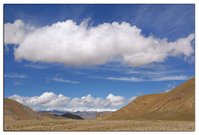 |  |
| You can experience all sort of road conditions in this route. | One of the most dangerous spot in this route. |
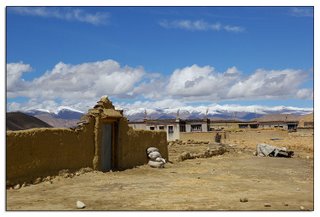 | 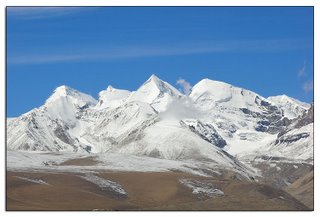 |
| This is the typical Tibetan houses you can see in this area -- the house has the special Sakya 3-colour strips, the roof has layers of yak dung (locals burn dung for fire), and at the corner, you see decoration of hay. | Though not 100% sure, I think this is probably Mt Cho Oyu (卓奥友峰), 8,201m, the 6th highest mountain in the world. |

We arrived Old Tingri around 2:30pm. Nothing special in the town. We took a 2-hour break, had lunch in a Tibetan restaurant, said goodbye to Peter and the gang, then restarted my journey. Next destination is Porong village (波绒乡), a small town in the Mt Shishapangma area.
Right after we left the town Tingri, I found some very interesting photo opportunities at the roadside of the Sino-Nepal Friendship Hwy -- a vast grassland with Mt Qomolangma and Mt Cho Oyu stand in distant background. At the front, there are several large ponds. Water are crystal clear, and the reflection of those snow covered mountains
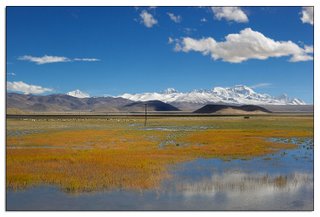 |  |
| Mt Qomolangma (Everest) and Mt Cho Oyu. Viewed from roadside, about 2km from Old Tingri. | Mt Cho Oyu, 8,201m I can imagine sunset in here will be phenomenal |
It was about a 2-hour drive from Tingri to Porong. About 5km before Porong town, Mt Shis
 hapangma shows up from the left. The first impression of the mountain wasn't so good, compares to Mt Qomolangma, Shishapangma has nothing to be proud of.
hapangma shows up from the left. The first impression of the mountain wasn't so good, compares to Mt Qomolangma, Shishapangma has nothing to be proud of.According to my research, there is no guesthouse in Porong. We had to stay over night in local people's house. I thought that should be easy to deal with since my driver is a Tibetan. However, Mr. Danzeng did not look like he like that idea (well, maybe he has been living in Lhasa for too long, and already gets used to the lifestyle of having a clean bed to lay his body down ;P). On the way to the village, he stopped a truck that was coming out from the village, and asked the driver about the accommodation in Porong. That driver told us that there was no place to stay in the village, and about 3km from here, there is a checkpoint for the Shishapangma National Park. We can stay in the checkpoint. Obviously, Mr. Danzeng was delighted to hear this. So we moved on...
The checkpoint locates in the center of the vast Shishapangma plain (well, I really don't know what its name is). The office attaches to a courtyard that is served as the dormitory of tibetan road workers. The workers were kind enough to offer us a bed for tonight. All set, now I can concentrate on taking pictures.
After dinner, workers gathered together and started their daily gossip time. I had no idea what they were talking about, because they spoke only in Tibetan. However, by courtesy, I still sat in the room and "listened" to their conversation, although what I really did was casting my mind back to the beautiful scene I saw today. I just wished they could finish the gossip as soon as possible so that I could go to bed early. However, that did not happen -- they started drinking beers, bottle after bottle! (this surprised me, because during dinner, one worker told me that many workers in the room are not permanent workers. Being in temporary status, their wages were extremely low, about 20-25 yuans/day. Then how could they afford the beers, because beers in this place are not cheap?) The long hours of sitting on
Shortly after left the Shishapangma checkpoint (a benefit of staying a night in the checkpoint is, the park guard considered we were friends to them so he waived our entrant fee to the park! :P), Mt Kangbochen (康波钦峰,又名岗彭庆) appears at the left side of the road. This mountain is much closer to us than is the Shishapangma, so it looks higher, although in fact it is about 800m shorter. Any way, t  he shape of Kangbochen is much more beautiful than that of the Shishapangma, at least when view from the highway. he shape of Kangbochen is much more beautiful than that of the Shishapangma, at least when view from the highway.An hour later, we arrived at the shore of lake Pekhu-tso (佩枯错). Although this lake is highly touted in many tour books, I did not feel it was any special -- a rather ordinary lake by Tibet's standard (there are way too many beautiful lakes in Tibet). The blue of the lake is very bright and brilliant though. Well, the lake may be beautiful, but the weather today might not justify its beauty -- it was too fine a day that not trace of clouds can be found on the sky! This render the scene very dull, at least when look from the viewfinder of my camera. Visit my website at fototi.com for many photos of the Mt Shishapangma area. 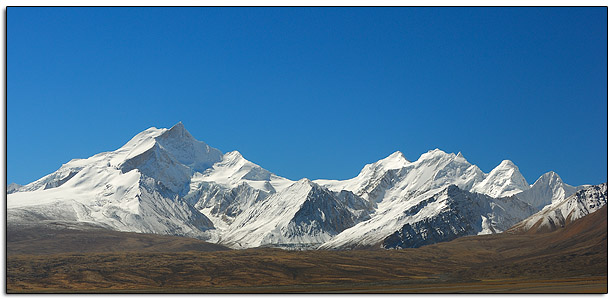 Previous story: Mt Qomolangma (Mt Everest) |
